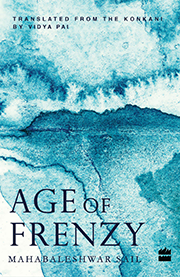
The Moravian Night by Peter Handke, tr. Krishna Winston, Farrar, Straus and Giroux
Review: Laura Garmeson, Assistant Copyeditor
Not long after midnight, with wintry constellations etched across the Serbian sky, a group of six or seven men make their way through the darkness from various nearby villages to approach the Morava River, a tributary of the Danube. They have been summoned by the owner of a houseboat moored by the riverbank, guided by its neon sign blazing the boat’s name: “Moravian Night”. Once on board, they are greeted by a man who was formerly a well-known writer. He extinguishes the glowing sign, calls for silence, and begins to tell the listeners his story.
So begins The Moravian Night, the latest shimmering, introspective novel to appear in English from the renowned Austrian author Peter Handke, translated from the German by Krishna Winston and published by Farrar, Straus and Giroux. Handke is no stranger to controversy, with his support for Serbia’s Milošević in the 1990s provoking widespread outrage, and the alchemy of this work seems to draw from the political life and writing life of its author. Employing cameo appearances of characters from previous Handke novels and plot points about the fallout of Central European projects and failed Balkan states, Handke toys with reality, as he sees it, through the cracked lens of fiction.
The resulting book, which on the surface is the story of the nameless writer’s journey across Europe from east to west, is really a travelogue of the mind. This obscured narrator travels through the Balkans, Spain, and Germany, retraces his own steps from previous decades, and reencounters figures who were once figments of memory: “the longer he walked the more he fell into his previous footsteps, footsteps of air”. The parallels to One Thousand and One Nights are established in the book’s first scene, and continue with the same undercurrent of danger and threat of death that forced Scheherazade’s stories into being. The narrator seems impelled by the same threat in the dark on board the Moravian Night. Storytelling here is the antithesis of death – the recreation of a life – and a disrupter of time.
Mysterious, brimming with ideas, and written in prose imbued with an unmistakeable mythical quality, Handke’s The Moravian Night addresses, with brilliant and thoughtful poetry, the elusiveness of being. In reading his “geography of dreams” we, too, are challenged by a question that is both fearsome and beautiful: “Had the night’s undertaking been nothing but seizing a handful of dust?” Translator Krishna Winston has wielded Handke’s prose with skill and precision.

Ema, the Captive by César Aira, tr. Chris Andrews, New Directions
Review: Poupeh Missaghi, Editor-at-Large for Iran
The title of Aira’s most recently translated book – Ema, the Captive – creates the expectation, even before one opens the book, that it will tell the story of a captive woman. Interestingly, the book opens with a portrait of a landscape, and the soldiers and horses traveling through it, a few convicts and a French engineer in tow. No trace of the titular Ema in the opening pages of the book. She appears on page 41, spotted by Frenchman, who himself turns out to be a marginal character, while nursing her baby. And then, without the reader realizing, without her captors ultimately realizing, she gradually overtakes the narrative, of the book and of her life.
In her captivity, Ema is passed on from one man to another: to the engineer, now to the lieutenant; she then becomes wife to several husbands, takes lovers, becomes a captive again; the cycle seems to go on forever. She gives birth to more children, caring for them while caring for herself. She moves through the pampas of Argentina, the frontier, the fort, the harem of the palace, etc. She meets soldiers, men and women of the court, ministers, Indians. Seasons pass and time makes great leaps. And Ema survives, going along with life, wherever it takes her, until suddenly she wants to go live on a breeding farm.
Soon Ema is employing people, trading goods, building a farm, and breeding pheasants. It doesn’t come to us, or to Ema, however, as a surprise, since the circumstances seem kind of the same . “Leaving the court, which she had imagined as a perilous leap, turned out to be so easy it was barely noticeable. Everything simply vanished, and within a few weeks she found that she had settled into different but similar surroundings”. The real narrative is Ema’s continuous inner journey, independent of her surroundings – it is her sense of self, above all, that shapes her life.
Ema, the Captive takes us on a violent journey, but it does so with serenity and impassivity. So vast, and yet so immediate, the book, like its landscapes and its main character, presents us with a spectacle. Destiny and meaning keep lurking in the wings, but so does meaninglessness, and none take center stage. As Ema says about one of her afternoons, “Meaninglessness was always on the point of breaking out, it seemed, but at the critical moment, nothing happened. Or rather, there was no critical moment. It was all repetition. It was exactly what people call ‘a magical afternoon’”. This is exactly what reading the book feels like: spending a magical afternoon in Ema’s world, without knowing what made it magical.

Age of Frenzy by Mahabaleshwar Sail translated from the Konkani
Review: Janani Ganesan, Assistant Managing Editor
The day after a cyclone lashed the city of Chennai in southern India this month, a sizeable group of people milled about a neighbourhood temple. As the streets remained graveyards to the uprooted trees older than the concrete temple built in haste, there was a celebratory air about. It was the festival of Karthigai and people prayed to appease the Gods after the dreadful storm, or perhaps offered thanks for having been spared. Ten lakh people had thronged to a famous temple the previous day, braving the cyclone, to participate in the festivities. No argument or illustration need be made for the power of religious faith. Despite being well acquainted with this, I was still stunned that the faith of my neighbours was as single-minded as that of the 16th century residents of a village portrayed in Mahabaleshwar Sail’s novel Age of Frenzy.
Religious faith’s ubiquitous power makes it an explosive subject to handle, especially through the genre of the historical novel (although the author prefers to call it “a piece of creative writing that is based on historical events”). Even more so in a country where religious battles unfold in the street corner every day and religious myths are passed off as history in a court of law.
Knowing this only too well, Sail tells translator Vidya Pai in an interview:
“I believe in God, but not in any organized religion; by confining God within the framework of organized religion we breed intolerance of other faiths. So, my God, who is present in the whole universe, does not need temples or rituals or priests. But this was a very delicate, sensitive theme. It would have to be handled with maturity and restraint. If the balance were upset in any way religious sentiments would be hurt and that was not my intent.”
Ticking off the majority Hindu population in India can result in exile or even death—all the more reason for the writer to tread with care. But perhaps this caution has led Sail to sacrifice what could have been a formidable, moving novel, published in its original Konkani in 2004.
(An aside for readers unfamiliar with the language: Konkani is spoken in the south western parts of India, including Goa, the country’s smallest state. It suffered under Portuguese oppression—evolving into various dialects by absorbing the dominant language of different states the migrants spread to—and after the Portuguese exit in 1961, under the postcolonial state’s negligence. Age of Frenzy plunges into the heart of the chaos that drove the language and a culture to the margins.)
Setting his 304-page novel in the imaginary village of Adolshi, Sail traces how a few hundred devout Hindu families that constitute this village are converted to Christianity during the Portuguese rule. Sail re-imagines the different forces unleashed on their community—promise of a new, compassionate faith; fear of loss of land and livelihood; and threats of torture and death. The fallout for these families, whose birth, death, and every other aspect of life depend on their chosen religion, fill even an atheistic reader with empathy, but only momentarily. Where are the caste tensions typically present in a fiercely Hindu village? One wonders, after the flash flood has dried up. Apart from a scene where the compassionate padre Simao Peres questions an old man about his status as an untouchable, members of the low-caste community of Mhars are never mentioned again; their interactions with the upper-caste muted from the novel. Even in this scene, the old man is stripped of agency, ignorant of the discrimination against himself. The novel further toes the dominant narrative by portraying most of the land-owning class and Brahmins as enlightened souls. A scene that shows the cruelty in the practice of Sati—when a widow is pushed onto the funeral pyre of her husband—is the only instance where the practices of the Hindu religion are presented in a cruel light. While the Christian proselytizers are put through a critical lens, the Hindus are cast mostly as victims. The above-mentioned exceptions hardly fill in as token gestures of critique.
Did Sail wonder if focussing on the friction within the caste would take away from the stories of religious conversion? That would make this a poorer historical novel that fails to capture the complexities surrounding conversion from a strictly hierarchical religion to a supposedly egalitarian one. Shifting too quickly between too many characters, Age of Frenzy conjures up a broad sense of empathy for the upper caste society forced into abandoning a faith but without exploring the privilege that such a faith sanctioned its dominant adherents.
*****
Read More Reviews:

